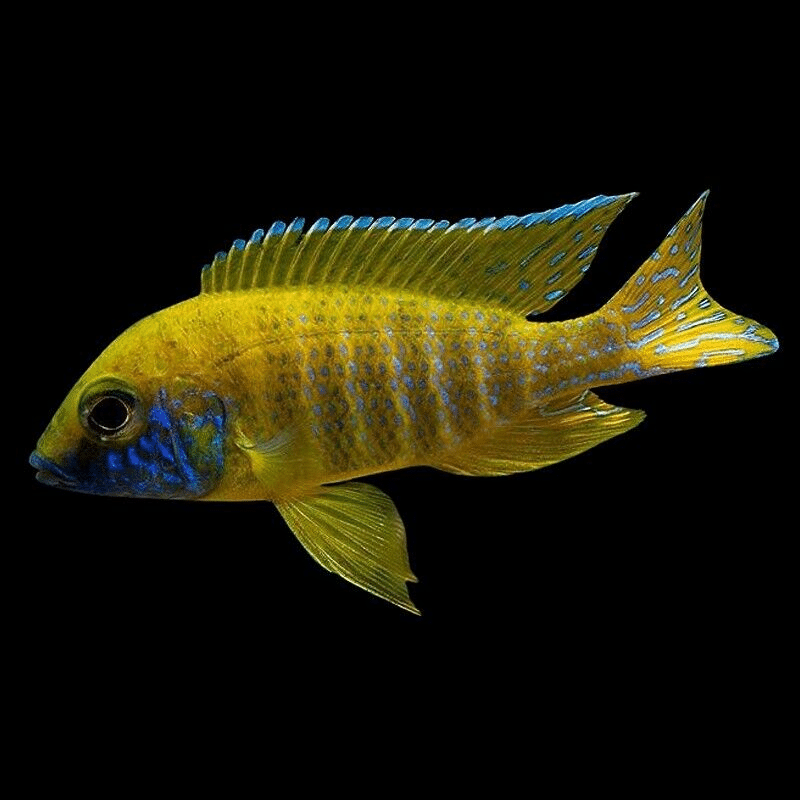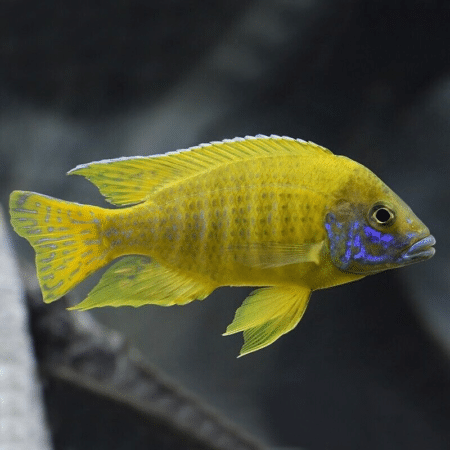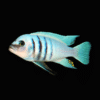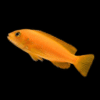Subtotal: £25.16
Nkhomo-Benga Peacock Cichlid – Aulonocara Baenschi – Lake Malawi Cichlid, Vibrant African Cichlids That Thrive in Well-Planted Tanks, Perfect Companions for Your Aquarium
£12.99 Original price was: £12.99.£10.65Current price is: £10.65.
Welcome the stunning Nkhomo-Benga Peacock Cichlid (Aulonocara Baenschi) into your aquarium! Known for its vibrant colors and elegant movement, this Lake Malawi cichlid is a perfect addition for aquarists seeking beautiful inhabitants. Ideal for community tanks, these peaceful companions thrive with proper care.
1000 in stock
Species Introduction
The Nkhomo-Benga Peacock Cichlid, scientifically known as Aulonocara baenschi, is a stunning species of freshwater fish originating from the vibrant waters of Lake Malawi in East Africa. This particular cichlid is renowned for its vivid coloration and unique patterns, making it a popular choice among aquarium enthusiasts. The Nkhomo-Benga variety is especially appreciated for its striking blue and yellow hues, which can vary significantly among individuals. In their natural habitat, these cichlids inhabit rocky shorelines and sandy bottom areas, where they find shelter among the rocks and vegetation. Understanding their natural environment is crucial for replicating their habitat in a home aquarium, ensuring that these aquatic companions thrive.
Care Requirements Dashboard
| Optimal Living Conditions | |
|---|---|
| Water Temperature | 24-27°C (75-81°F) |
| pH Level | 6.5-7.5 |
| Water Hardness | 4-12 dKH |
| Minimum Tank Size | 80L (20 gal) |
| Salinity | Freshwater |
| Care Level | Beginner Friendly |
Natural Behavior & Temperament
The Nkhomo-Benga Peacock Cichlid exhibits a fascinating array of behaviors that are essential for any aquarist to understand. These fish are generally peaceful but can display territorial tendencies, especially during breeding. They prefer to establish a hierarchy within their social structure, which can lead to some aggression if not managed properly. In a community aquarium, it is crucial to provide ample hiding spots and territories to reduce stress among tank mates. Observing their social interactions can be a rewarding experience, as they engage in playful displays and courtship rituals. Their natural inclination to swim in the mid to upper levels of the tank makes them an active and engaging species to watch. Understanding their behavior will enhance your experience as you provide a home for these beautiful creatures.
Tank Setup Guide
Creating an ideal environment for the Nkhomo-Benga Peacock Cichlid involves careful consideration of tank setup. A minimum tank size of 50 gallons is recommended to accommodate their swimming needs and territorial behavior. The substrate should consist of fine sand or small gravel, mimicking their natural habitat. Incorporating rocks, caves, and driftwood will provide hiding spots and territories, essential for reducing stress and aggression. Live plants can also be added, but it is important to choose hardy species that can withstand the cichlid’s digging behavior. Lighting should be moderate, as these fish thrive in environments that replicate the natural light conditions of Lake Malawi. Proper aquascaping not only enhances the aesthetic appeal of the aquarium but also promotes the well-being of your aquatic companions.
Water Quality Management
Maintaining optimal water quality is paramount for the health of the Nkhomo-Benga Peacock Cichlid. Regular monitoring of water parameters is essential to ensure a stable environment. The pH level should be kept between 7.8 and 8.6, with a temperature range of 76°F to 82°F. Hardness levels should ideally be between 10 and 20 dGH. Regular water changes of 20-30% every two weeks will help maintain water clarity and quality. Utilizing a high-quality filtration system is recommended to keep the water clean and well-oxygenated. Additionally, testing kits for ammonia, nitrite, and nitrate levels should be used to prevent toxic build-up. By prioritizing water quality management, you can create a thriving environment for your cichlid friends.
Feeding & Nutrition
The dietary needs of the Nkhomo-Benga Peacock Cichlid are diverse, requiring a balanced diet to promote health and vibrant coloration. These fish are primarily carnivorous, thriving on high-quality pellets, flakes, and frozen foods such as brine shrimp, bloodworms, and daphnia. A varied diet will not only enhance their colors but also support their overall health. It is recommended to feed adult cichlids once or twice a day, providing only what they can consume within a few minutes to prevent overfeeding. Young Nkhomo-Benga cichlids require more frequent feedings to support their growth. Additionally, incorporating vegetable matter, such as spirulina flakes, can aid in digestion and provide essential nutrients. Understanding their nutritional needs is vital for ensuring the well-being of these beautiful fish.
Compatibility Guide
When considering tank mates for the Nkhomo-Benga Peacock Cichlid, it is essential to choose species that can coexist peacefully. These cichlids can be territorial, especially during breeding, so selecting compatible tank mates is crucial. Ideal companions include other African cichlids that share similar water parameters and temperaments. Species such as the Yellow Lab (Labidochromis caeruleus) and the Red Zebra (Maylandia estherae) can make excellent tank mates. However, it is advisable to avoid smaller fish that may become targets of aggression. Additionally, keeping multiple males in the same tank can lead to increased territorial disputes, so it is best to maintain a ratio of one male to several females. Understanding the dynamics of your aquarium community will help create a harmonious environment for all inhabitants.
Health & Wellness
The health and wellness of the Nkhomo-Benga Peacock Cichlid are influenced by various factors, including water quality, diet, and social interactions. Common health issues include ich, fin rot, and bloat, often resulting from poor water conditions or stress. Regular monitoring of fish behavior and appearance is essential for early detection of health problems. Signs of illness may include lethargy, loss of appetite, or abnormal swimming patterns. To prevent health issues, maintaining stable water parameters and providing a balanced diet is crucial. If any health concerns arise, it is important to act quickly, isolating affected fish and treating them appropriately. By prioritizing the health of your cichlid friends, you can ensure a long and vibrant life for these beautiful creatures.
Breeding Information
Breeding the Nkhomo-Benga Peacock Cichlid can be a rewarding experience for aquarists. These fish are mouthbrooders, meaning the female carries the fertilized eggs in her mouth until they hatch. To encourage breeding, it is essential to provide a well-decorated tank with plenty of hiding spots. The male will display vibrant colors and perform courtship dances to attract the female. Once the female is ready to spawn, she will lay eggs on a flat, clean surface, which the male will fertilize. After spawning, the female will collect the eggs in her mouth for incubation, which typically lasts about three weeks. After hatching, the fry will remain in the female’s mouth for protection until they are ready to swim freely. Providing a separate rearing tank for the fry can help ensure their survival and growth.
Acclimation Process
Proper acclimation is crucial when introducing the Nkhomo-Benga Peacock Cichlid to a new aquarium. Sudden changes in water parameters can cause stress and shock, potentially leading to health issues. The acclimation process should begin by floating the sealed bag containing the fish in the aquarium for about 15-20 minutes, allowing the water temperature to equalize. After this, gradually introduce small amounts of aquarium water into the bag every 10-15 minutes for about an hour. This gradual mixing helps the fish adjust to the new water chemistry. Once acclimated, gently release the fish into the tank using a net to avoid adding any transport water. By following these steps, you can ensure a smooth transition for your new aquatic companions.
Long-term Care
Long-term care of the Nkhomo-Benga Peacock Cichlid involves regular maintenance of their environment and monitoring their health. These fish can live for several years with proper care, so establishing a routine is essential. Regular water changes, testing water parameters, and maintaining a clean tank are crucial for their well-being. Additionally, observing their behavior and interactions with tank mates will help identify any potential issues early. As they grow, it is important to reassess tank size and compatibility with other fish. Providing a balanced diet and monitoring their health will contribute to a long and vibrant life for your cichlid friends. Remember, creating a stable and nurturing environment is key to their happiness.
Natural Habitat Recreation
Recreating the natural habitat of the Nkhomo-Benga Peacock Cichlid in your aquarium is essential for their well-being. In Lake Malawi, these fish thrive among rocky structures and sandy bottoms, so your tank should reflect this environment. Incorporating a mix of rocks, caves, and sandy substrate will provide hiding spots and territories that mimic their natural surroundings. Additionally, adding live plants can enhance the aesthetic appeal while providing cover and foraging opportunities. Lighting should be moderate to replicate the natural light conditions of their habitat. By focusing on natural habitat recreation, you can create a thriving environment that supports the health and happiness of your aquatic companions.
Seasonal Care Adjustments
Seasonal changes can impact the care requirements of the Nkhomo-Benga Peacock Cichlid. During warmer months, it is important to monitor water temperature closely, as higher temperatures can lead to stress and health issues. Adjusting the heater settings and ensuring adequate water circulation can help maintain stable conditions. Conversely, during colder months, you may need to increase heating to keep the water within the ideal range. Additionally, changes in lighting duration may be necessary to simulate natural day/night cycles. Regular monitoring and adjustments will ensure that your cichlid friends remain healthy and comfortable throughout the year.
Expert Tips
For those looking to provide the best care for the Nkhomo-Benga Peacock Cichlid, consider these expert tips. Firstly, ensure that the tank is adequately filtered and aerated to maintain high water quality. Regularly test water parameters and perform partial water changes to keep the environment stable. Secondly, observe your fish closely for any signs of stress or illness, as early detection is key to successful treatment. Lastly, consider joining online forums or local fish clubs to share experiences and gain insights from other cichlid enthusiasts. By implementing these tips, you can enhance your knowledge and provide optimal care for your aquatic companions.
Troubleshooting
Despite your best efforts, you may encounter challenges while caring for the Nkhomo-Benga Peacock Cichlid. Common issues include aggression among tank mates, health problems, or fluctuations in water quality. If aggression occurs, consider rearranging the tank to disrupt established territories or adding more hiding spots. For health issues, isolate affected fish and consult a veterinarian or aquatic specialist for treatment options. If water quality fluctuates, reassess your filtration system and perform regular maintenance to ensure a stable environment. By being proactive and knowledgeable, you can effectively troubleshoot and maintain a thriving aquarium.
Scientific Background
The Nkhomo-Benga Peacock Cichlid belongs to the family Cichlidae, a diverse group of freshwater fish known for their vibrant colors and complex behaviors. Cichlids are found in various aquatic environments, but the species from Lake Malawi are particularly notable for their evolutionary adaptations and unique breeding behaviors. Research into cichlid taxonomy and behavior continues to provide insights into their ecology and conservation. Understanding the scientific background of your cichlid friends can enhance your appreciation for these remarkable fish and their role in the aquatic ecosystem.
Advanced Care Techniques
For experienced aquarists looking to take their care of the Nkhomo-Benga Peacock Cichlid to the next level, consider implementing advanced techniques. Utilizing a breeding setup with separate tanks for males and females can improve breeding success rates. Additionally, experimenting with different food types, including live and frozen options, can enhance coloration and health. Regularly participating in cichlid shows or competitions can also provide valuable feedback and recognition for your efforts. By continually expanding your knowledge and skills, you can ensure the best possible care for your aquatic companions.
Frequently Asked Questions
Q: What tank size is required for the Nkhomo-Benga Peacock Cichlid?
The Nkhomo-Benga Peacock Cichlid, being a vibrant and active species, requires a tank of at least 200 litres to thrive. This size provides ample swimming space and allows for the establishment of territories, which is crucial for their behavioural health. A larger tank not only reduces stress but also helps maintain stable water parameters, which these fish are sensitive to. Additionally, a well-planted aquarium with hiding spots will contribute to their comfort and well-being. As they can be territorial, particularly during breeding, ensuring sufficient space can help mitigate aggression among tank mates.
✓ Expert Tip
Consider adding caves and rocky structures to mimic their natural habitat, enhancing their comfort and reducing aggression.
Q: What water parameters do Nkhomo-Benga Peacock Cichlids require?
Nkhomo-Benga Peacock Cichlids thrive in slightly alkaline water with a pH level ranging from 7.8 to 8.6. The temperature should be maintained between 24°C to 28°C, ideally around 26°C for optimal health. Hard water is preferable, with a hardness level of 10-20 dGH, reflecting their natural Lake Malawi habitat. Regular monitoring of these parameters is vital, as fluctuations can stress the fish and lead to health issues. Investing in a quality water testing kit will assist in maintaining these conditions effectively.
✓ Expert Tip
Perform regular water changes of 20-30% weekly to keep water parameters stable and reduce the risk of disease.
Q: How often should I feed Nkhomo-Benga Peacock Cichlids?
Feeding Nkhomo-Benga Peacock Cichlids should occur 2-3 times a day, ensuring they receive a balanced diet. High-quality pellets designed for cichlids can form the basis of their diet, supplemented with frozen or live foods such as brine shrimp and bloodworms to enhance nutrition and colour. It is essential to provide only what they can consume within 2-3 minutes to avoid overfeeding, which can lead to poor water quality and health problems. Regularly varying their diet can also help keep them active and healthy.
✓ Expert Tip
Consider using a feeding ring to prevent food from drifting away and ensure that all fish have access to the food.
Q: What are the best tank mates for Nkhomo-Benga Peacock Cichlids?
When selecting tank mates for Nkhomo-Benga Peacock Cichlids, it is crucial to choose species that can withstand similar water parameters and exhibit compatible temperaments. Suitable companions include other African cichlids such as Mbunas or other Aulonocara species, as they share similar habitats and behaviours. Avoid mixing them with overly aggressive species, as this can lead to stress and territorial disputes. Ensuring a larger tank with plenty of hiding spots and territories can also help reduce aggression and promote a peaceful community.
✓ Expert Tip
Introduce new tank mates gradually and monitor their interactions to ensure a harmonious environment.
Q: How do I properly acclimatise Nkhomo-Benga Peacock Cichlids to my aquarium?
Acclimatising your Nkhomo-Benga Peacock Cichlids is essential to reduce stress and ensure their health. Start by floating the sealed bag in the tank for about 15-20 minutes to equalise the temperature. After this, gradually mix tank water into the bag over another 30-60 minutes. This process, known as drip acclimatisation, helps the fish adjust to the water parameters of their new environment. Once acclimatised, gently release the fish into the tank, avoiding adding bag water to the aquarium to prevent contamination.
✓ Expert Tip
Keep the lights dim during acclimatisation to reduce stress on the fish.
Q: What are the signs of healthy Nkhomo-Benga Peacock Cichlids?
Healthy Nkhomo-Benga Peacock Cichlids exhibit vibrant colours, clear eyes, and active swimming behaviour. They should display a healthy appetite and show interest in their surroundings. Observe for any signs of distress, such as hiding excessively, lethargy, or abnormal swimming patterns, which may indicate stress or illness. Regular monitoring of their behaviour and physical condition can help you catch any potential health issues early, allowing for prompt treatment.
✓ Expert Tip
Maintain a stable environment and good water quality to promote overall health in your fish.
Q: How do I successfully breed Nkhomo-Benga Peacock Cichlids?
Breeding Nkhomo-Benga Peacock Cichlids can be rewarding but requires careful planning. To encourage breeding, ensure you have a healthy male and female pair, ideally in a tank with plenty of hiding spots and open swimming areas. When conditions are right, the female will lay eggs in a secure location, which the male will then fertilise. Post-spawning, the female will mouth-brood the eggs until they hatch. It is crucial to provide a separate breeding tank to protect the fry from aggressive tank mates and ensure their survival.
✓ Expert Tip
Monitor the breeding pair closely, as males can become aggressive during this time.
Q: What temperature should I maintain for Nkhomo-Benga Peacock Cichlids?
Maintaining the correct temperature is crucial for the health of Nkhomo-Benga Peacock Cichlids. Ideally, the water temperature should be kept between 24°C and 28°C, with a stable environment being essential. Sudden temperature fluctuations can lead to stress and health issues. Investing in a reliable aquarium heater with a thermostat will help maintain the desired temperature. Regular checks with a quality thermometer will ensure the environment remains consistent, promoting the overall well-being of your fish.
✓ Expert Tip
Place the heater near a water flow area to ensure even temperature distribution throughout the tank.
Q: How long do Nkhomo-Benga Peacock Cichlids typically live in captivity?
In captivity, Nkhomo-Benga Peacock Cichlids can live for approximately 5 to 10 years, depending on their care and environment. Providing optimal water conditions, a balanced diet, and a stress-free environment can significantly influence their lifespan. Regular health checks and prompt attention to any signs of illness will also contribute to their longevity. As with any aquatic companions, the better the care, the longer they are likely to thrive.
✓ Expert Tip
Keep detailed records of water parameters and feeding schedules to optimise their care.
Q: What type of substrate is most suitable for Nkhomo-Benga Peacock Cichlids?
For Nkhomo-Benga Peacock Cichlids, a sandy substrate is the most suitable option, as it mimics their natural habitat in Lake Malawi. Sand allows them to sift through it without the risk of injury, which can occur with sharp substrates. Additionally, a sandy base can help to maintain water quality, as it provides a medium for beneficial bacteria to thrive. Ensure the substrate is at least 2-3 inches deep to allow for natural digging behaviour, which is essential for their comfort and health.
✓ Expert Tip
Avoid using gravel, as it can cause injury to their delicate mouths and hinder their natural behaviours.
Q: What behavioural patterns should I expect from Nkhomo-Benga Peacock Cichlids?
Nkhomo-Benga Peacock Cichlids are known for their vibrant colours and playful behaviour. They exhibit territoriality, especially males during breeding seasons. You may observe them displaying to attract females and defending their territory vigorously. In a well-maintained tank with adequate space and hiding spots, they can be quite sociable, often interacting with their tank mates. However, it is essential to monitor their interactions, as aggression can arise, particularly if they feel threatened or if their territory is encroached upon.
✓ Expert Tip
Provide plenty of visual barriers, such as rocks and plants, to help reduce stress and aggression.
Q: How can I prevent common diseases in Nkhomo-Benga Peacock Cichlids?
Preventing diseases in Nkhomo-Benga Peacock Cichlids starts with maintaining optimal water quality and stable parameters. Regular water changes, proper filtration, and avoiding overfeeding are crucial. Quarantining new fish before introducing them into the main tank can prevent the introduction of pathogens. Additionally, monitoring for signs of stress or illness, such as changes in behaviour or appetite, allows for early intervention. Providing a varied diet rich in nutrients will also strengthen their immune system, making them less susceptible to diseases.
✓ Expert Tip
Consider adding aquarium salt to the water during stressful situations to help maintain their health.
Q: What lighting conditions do Nkhomo-Benga Peacock Cichlids prefer?
Nkhomo-Benga Peacock Cichlids thrive under moderate lighting conditions. Bright lighting can cause stress and make them shy, so it is advisable to provide a more subdued light environment. Using LED lights with a dimming feature can allow you to adjust the intensity based on the time of day. Additionally, providing shaded areas using plants or decorations can help them feel secure while encouraging natural behaviours. A day/night cycle of about 10-12 hours of light is ideal for their well-being.
✓ Expert Tip
Consider using a timer to maintain a consistent lighting schedule, which can help regulate their natural behaviours.
Q: How do I recognise stress in Nkhomo-Benga Peacock Cichlids?
Recognising stress in Nkhomo-Benga Peacock Cichlids is vital for their health. Signs of stress include excessive hiding, lethargy, loss of appetite, or abnormal swimming patterns, such as darting or rubbing against objects. Additionally, changes in colour vibrancy can indicate stress, as stressed fish often exhibit duller colours. Monitoring their behaviour closely and ensuring a stable environment with optimal water quality and appropriate tank mates will help mitigate stress levels. Promptly addressing any signs of stress can lead to improved health and well-being.
✓ Expert Tip
If you notice signs of stress, consider rearranging the tank to provide a new environment and reduce territorial disputes.
Q: What natural habitat conditions should I replicate for Nkhomo-Benga Peacock Cichlids?
To create a suitable environment for Nkhomo-Benga Peacock Cichlids, replicate their natural habitat found in Lake Malawi. This involves providing a sandy substrate, rocky structures, and plenty of hiding spots to mimic their natural behaviour. The water should be slightly alkaline, with stable temperature and hardness levels. Additionally, incorporating plants that can thrive in similar conditions can enhance the aesthetics of the aquarium while providing cover. Maintaining good water quality through regular changes and filtration is also essential for their health and happiness.
✓ Expert Tip
Research the specific plants and rocks found in Lake Malawi to create a more authentic environment for your fish.


















Emily Carter (verified owner) –
I recently added the Nkhomo-Benga Peacock Cichlid to my 55-gallon tank, and I couldn’t be happier! These vibrant Aulonocara Baenschi really bring my aquarium to life with their stunning colors and energetic personality. After about two weeks of acclimation, they settled in beautifully, showcasing their striking blues and yellows that really pop against the planted background.
One of the standout features is their interactive nature; they are curious and often greet me when I approach the tank. It’s such a joy to see them swimming around! I have kept a few other African cichlids before, but I must say, the Nkhomo-Benga stands out for its peaceful temperament and unique coloration.
The shipping was fantastic too! They arrived promptly and in great health, which shows the seller’s commitment to fish welfare. My only minor concern is that they can be territorial during breeding, so I keep an eye on tank mates.
I highly recommend this tropical fish for anyone looking to add a splash of color and a lively personality to their aquarium. Perfect for both novice and experienced aquarists!